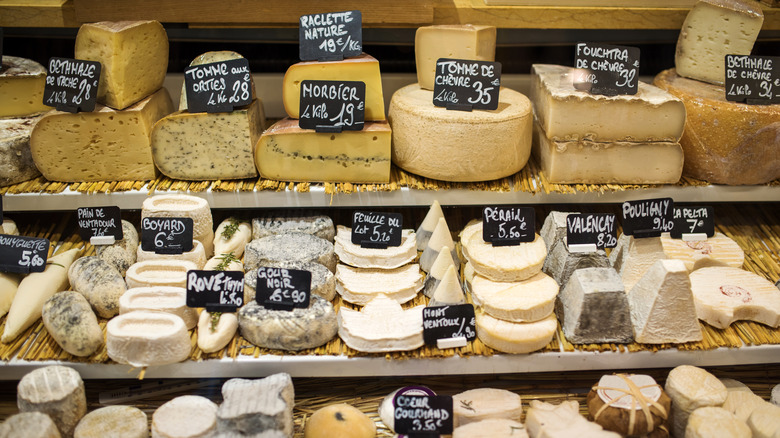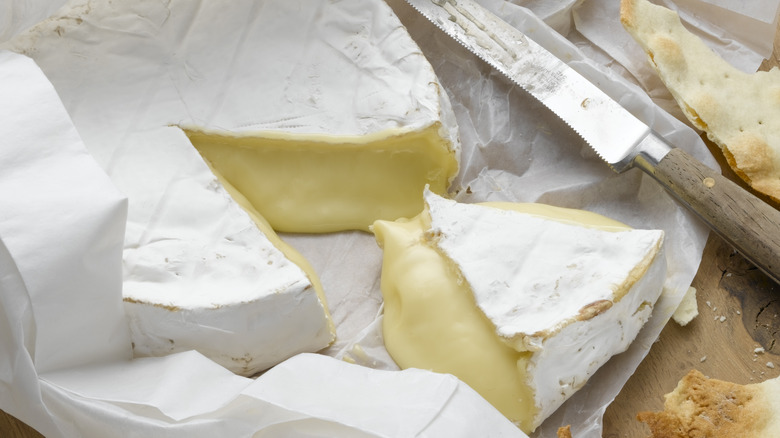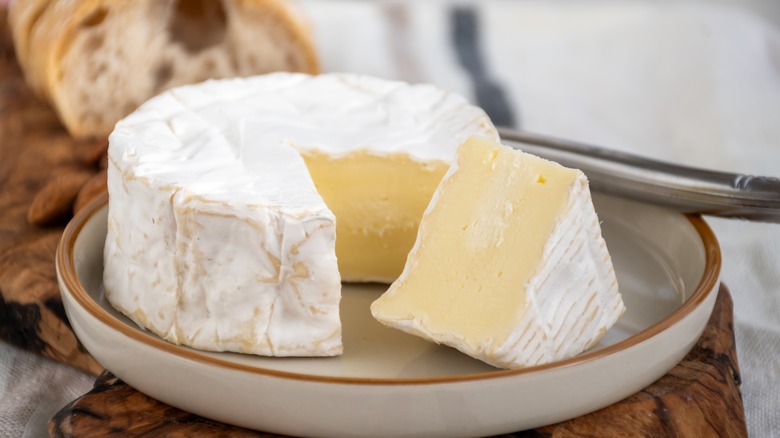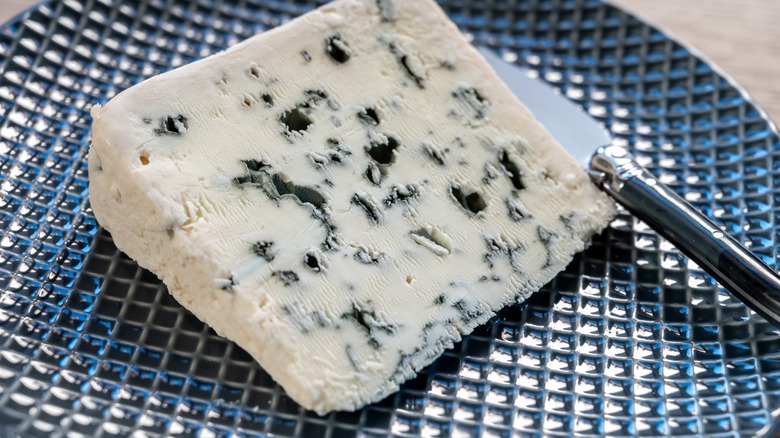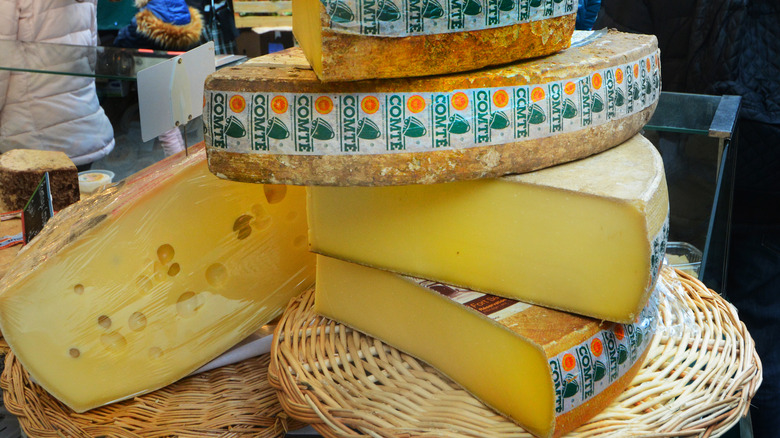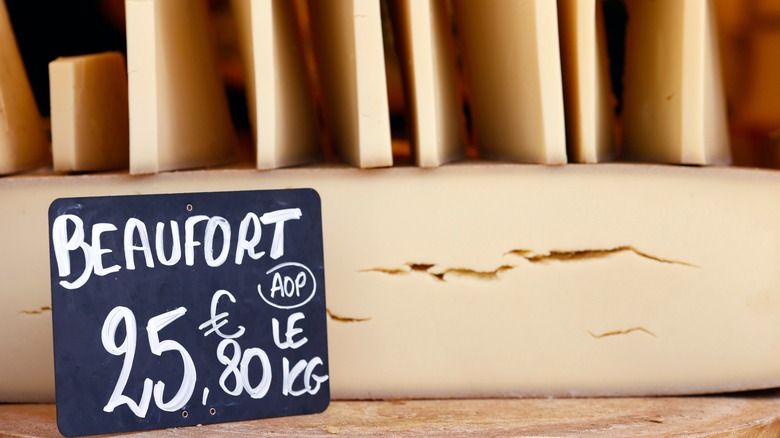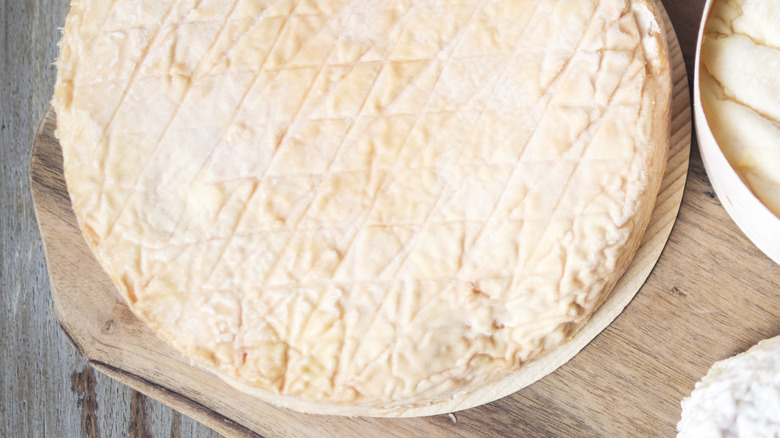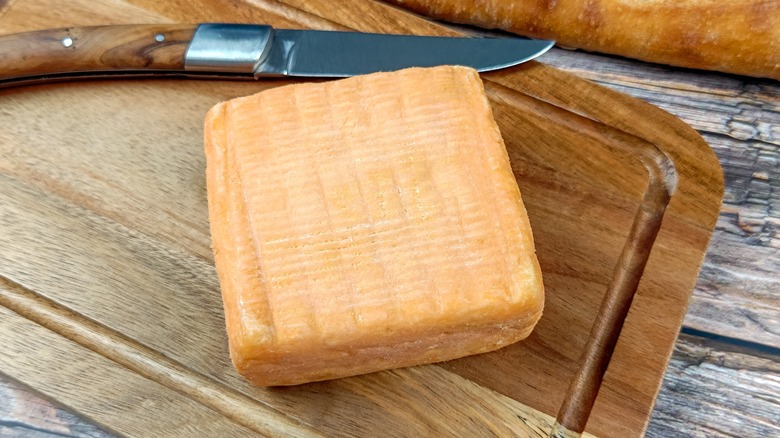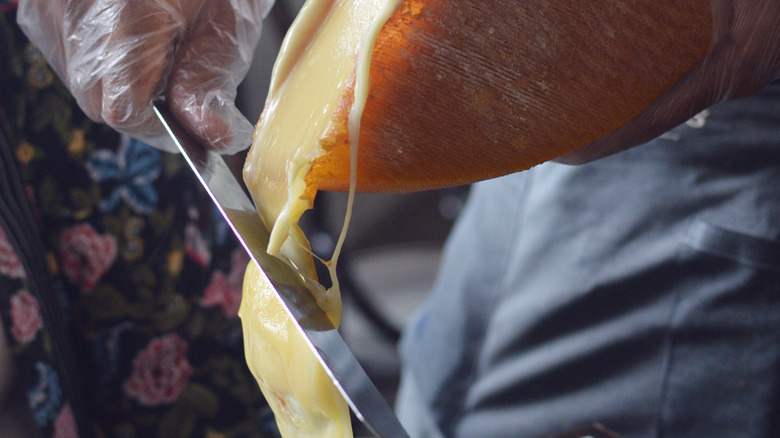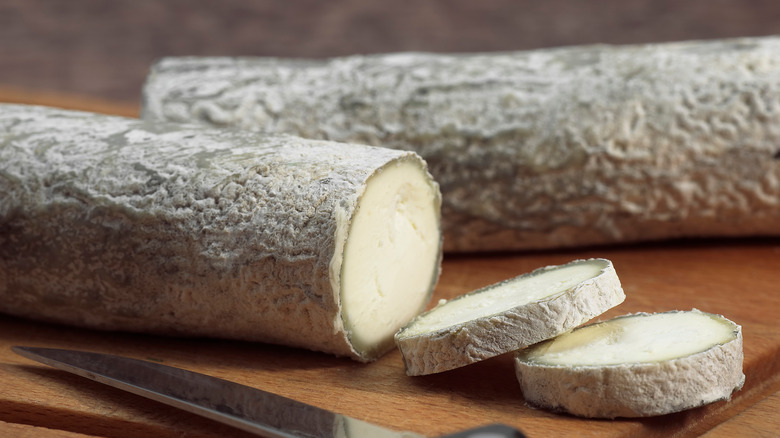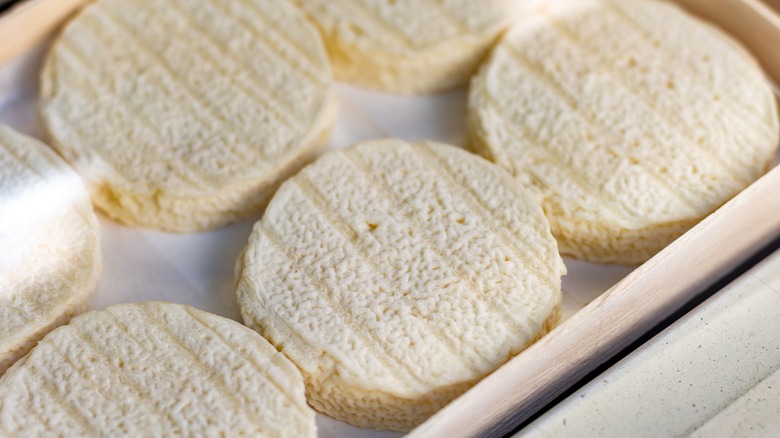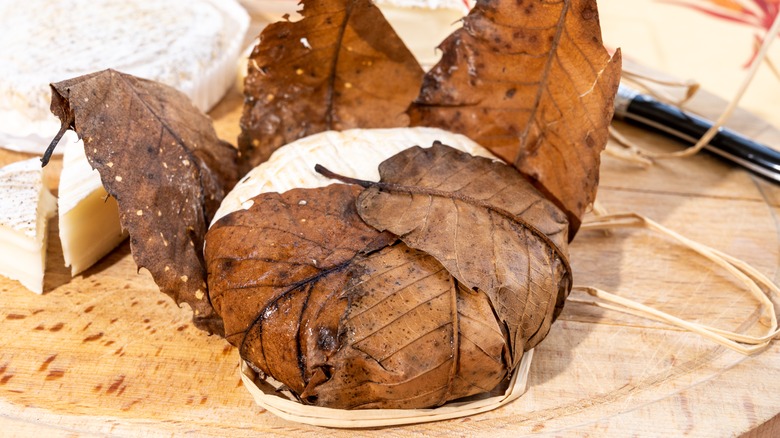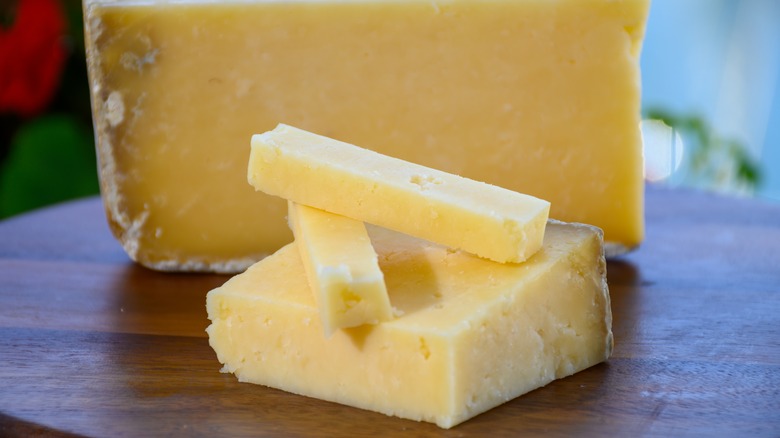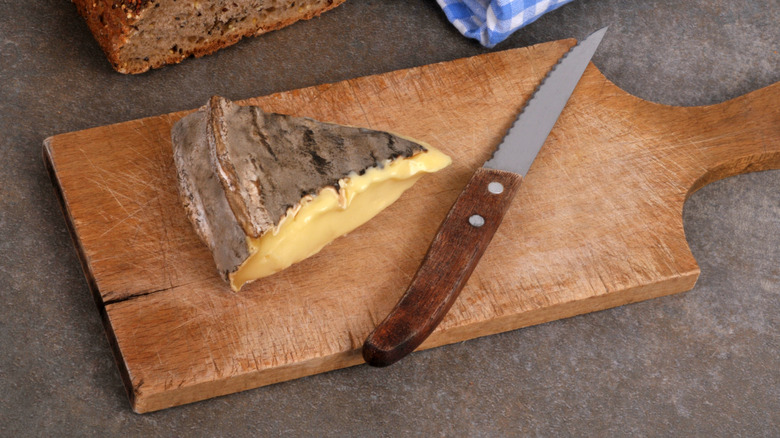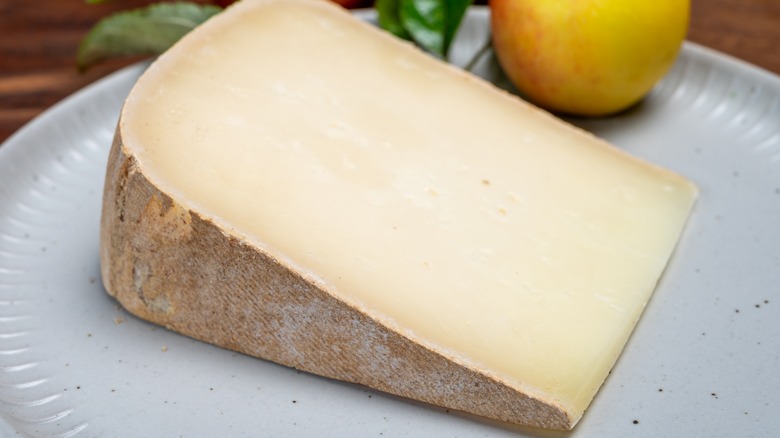14 French Cheeses You Need To Try At Least Once, According To Cheese Experts
Charles de Gaulle probably didn't say that it was impossible to govern a country with 246 kinds of cheese, but even if he had, his estimate would have been way off. France is home to an estimated 1,200 cheeses — and of these hundreds of cheeses, it's almost impossible to narrow the field. Asked to cite her favorite, cheesemonger Nathalie Quatrehomme of Fromagerie Quatrehomme desisted. "It's too hard!!" she says. "Having been raised in a cheese shop, I have too much love for the diversity of flavors and textures to choose just one. Sorry, but I pass!"
Tenaya Darlington, alias Madame Fromage, says that many French turophiles take the opposite view: hyper-specificity. "They'll say, 'I'm in a committed relationship with Beaufort, but only the Alpage version!'" she says. "Or they'll say, 'I Iike the goat cheese crottins from the Thursday market near my house, but I only buy them when they are dry and with little spots of blue mold.'"
If you're overwhelmed by choice in a fromagerie, cheesemonger Loïc Ferrière of Fromagerie Fernin recommends seeking out raw milk cheeses, which, he says, evolve with the season and are a truer expression of terroir. Of course, seeking out these delicacies in the U.S. can be complicated, especially those aged fewer than two months. But between those aged longer, like Comté and Beaufort, those you can seek out only in France, and a few pasteurized contenders worth their mettle, here are the French cheeses that experts think you should try.
1. Brie
Contrary to what you may believe, Brie is not the most popular soft cheese in France. That honor goes to Camembert — but more on that later. According to Madame Fromage, Brie is nevertheless the cheese Americans most often associate with France. "Supermarkets are full of little round Bries in wooden boxes with rustic packaging," she says. "I'd guess that's why Brie is the go-to French cheese that most Americans grab when they're putting on a party."
In France, however, Brie is not just Brie. Six different villages in this former region to the east of Paris lay claim to the soft cheese, with slightly different sizes, shapes, and flavor profiles characterizing each one. Two of these Bries — Brie de Meaux and Brie de Melun — are protected by Protected Designation of Origin (PDO), the same label that means that a sparkling wine made outside of a very specific 132 square mile region cannot be dubbed Champagne. Of the two, Brie de Meaux is the far more approachable, which may be why, according to cheese educator Jennifer Greco, it appears on so many French cheese boards. With a briny, vegetal character rich in mushroomy earthiness, Brie de Meaux definitely stands out from blander, pasteurized Bries you'll find in the U.S. — but it's hard not to fall in love with it.
2. Camembert de Normandie
The category of "bloomy-rinded" cheeses encompasses anything with a thick, white, mushroomy rind, from American Mt Tam to French Brie. And within the category, the undeniable French frontrunner is Camembert. "It long ago became an emblem of French gastronomy, similar to the baguette," explains cheesemonger Loïc Ferrière. And indeed, Camembert's rise to fame dates back over a century, to when its little wooden box made it far easier than other soft cheeses to transport by rail, which was rapidly gaining in popularity. Just a few decades later, the Norman specialty became the cheese par excellence in the ration packs of World War I-era soldiers, supplanting Emmental, which required more milk to produce. This sealed Camembert's fate as France's most popular bloomy. Soon, cheese lovers all over France were recreating the cheese that had brought them such comfort in the trenches.
But according to cheesemonger Nathalie Quatrehomme, this popularity also led to a decrease in quality. A lack of PDO regulation until 1982 led to a preponderance of facsimiles that pale in comparison to the taste of true Normandy Camembert, known for its oozy texture and intense aroma. But the times, she asserts, are changing for Normandy's most popular cheese. "Thanks to new small farmstead productions, Camembert de Normandie is once more finding its noble letters today," she says. Pierre Coulon is one such maker, one of just a handful making the raw milk cheese in the Norman town of Camembert.
3. Roquefort
Roquefort is one of the most "symbolic" French cheeses abroad, according to Pierre Coulon, founder of La Laiterie de Paris. Indeed, the image foreigners have of the French indulging in this intense sheep's milk blue cheese is no stereotype: about 16,000 tons of Roquefort are produced each year in the limestone caves of the Aveyron. While this amount may pale in comparison to the 250,000 tons of (mostly industrial) Emmental, it nevertheless cements Roquefort as France's second-most-produced PDO cheese.
Its PDO is part of what makes Roquefort so revered. Roquefort was the very first cheese to earn official recognition before the PDO label even existed, in 1925. Its Appellation d'Origine (AO) label gave the industry the strength to go to bat with the U.S. in 1948. Kathe Lison recounts in her book, "The Whole Fromage," that the Food and Drug Administration had set its sights on outlawing all raw milk cheese in the U.S. in the '40s, and Roquefort industrials were the ones to call in experts to testify that two months' aging made these cheeses safe to consume. But its outsized rep also makes Roquefort a target: In the wake of 2009 disputes over the European Union's decision not to import American hormone-laden beef, the U.S. threatened to levy import duty tariffs to the tune of 300%.
Roquefort offers a triple punch of intensity, due to its saltiness, sheepy lanolin, and bitter notes, power that makes it the fave of Madame Fromage. "It was my first love," she says, "and it always brings me to rapture."
4. Comté
If you set aside industrial Emmental and focuses exclusively on what Loïc Ferrière of Fromagerie Fernin dubs "table cheeses," there is one that rises to the top: Comté. "It's the most-sold PDO in France," he says, "and that's what we see in our shop."
A pressed cheese hailing from France's Jura region, Comté is traditionally made by cooperatives known as fruitères in massive, 88-pound wheels. Nutty and creamy, Comté is easy to love, and seeing as it can be sold at a variety of ages, there's a Comté for everyone. Comté can be sold beginning at four months of age, at which point it is quite fruity and rather supple in texture. From there, it is regularly aged to 12, 18, or 24 months, with rarer Comtés aged to 30, 40, or even 48 months. With every passing month in the deep, underground cellars, Comté grows nuttier in flavor and develops even more tyrosine crystals which crunch undertooth with every bite.
"Fruity Comté is our biggest seller," says Ferrière. "Many clients start their basket with a piece of Comté, and then they think about other cheeses." Pierre Coulon sees the same thing at his shop. "Pretty much all of our clients are going to leave with a slice of Comté," he says, particularly one aged 18 months. "It's pretty much in every French fridge." Nathalie Quatrehomme of Fromagerie Quatrehomme agrees, dubbing it "the King of French Cheeses!"
5. Beaufort
While Beaufort may look a bit like Comté at first glance, this Alpine cheese stands out thanks to its nutty flavor with slight pineapple notes, exhibiting less acidity than Comté. A mountain cheese par excellence, Beaufort is made to last, with a firm texture and a distinctive concave shape. In years gone by, this shape made it easier to bundle these cheeses onto the backs of mules to transport them into the valley for sale. For Métin Yapar, cheesemonger at Au Coeur du Marché cheese shops in Paris, it's a total French original. "There's nothing really like Beaufort," he says. "With Comté ... you've got Swiss Gruyère. It's the same process. Beaufort is Beaufort." For this reason, he says, of the 450 cheeses he sells, Beaufort is one of his top two go-tos.
But even within the realm of Beaufort, there is inborn variety. In winter, the cheese is made in the valley with the milk of cows that have been fed a hay-based diet. The milk is whiter than in summer, when a diet of Alpine pastures gives the cows' milk far more flavor. For cheesemonger Loïc Ferrière, there's nothing more comforting or delicious to enjoy in winter than "a bit of summer Beaufort," with the wildflower notes reminding you of the warm weather to come.
6. Soumaintrain
The stinkiest of French cheeses are in the washed-rind family, a category defined by a technique that sees the cheeses daubed in brine or alcohol to encourage the development of a sticky, stinky orange rind comprised of Brevibacterium linens — the very same bacterium that makes your socks stink. And according to Loïc Ferrière, this category is "very underestimated." Indeed, members of this category tend to be bolder on the nose than on the palate, with brothy, umami-rich flavors and a custardy, creamy texture.
For those willing to give these cheeses a try, Ferrière recommends beginning with a raw milk, farmstead Soumaintrain, a Burgundian delicacy developed by Cistercian monks in Pontigny in the Middle Ages. "This cheese is tender and creamy," adds Jennifer Greco, who adores its smoky undertones and notes of hay. "I absolutely love it with a glass of Sauternes," she says.
7. Maroilles
Perhaps the first washed rind cheese ever crafted in France was Maroilles, invented by monks on the Franco-Belgian border in the 7th century. This square cheese boasts a rusty color and a truly powerful odor, but according to Pierre Coulon, its bark is way worse than its bite. "There's this thing when it's young," he says, "it's pretty powerful on the nose, and not too much in the mouth. I find it pretty approachable. And above all in cooking, it's fantastic."
Compounded by the fact that there are quite a few farmstead producers of this cheese, he says, "it's nice to push people towards it, because it has a bit of a poor reputation." In France specifically, its PR was not helped by the 2008 film "Bienvenue Chez les Ch'tis," which saw France's north painted as a backwards region where locals ate the stinky cheese for breakfast, a habit the Southern protagonist found particularly offensive. Coulon's preference, meanwhile, is to cook with Maroilles, which becomes even milder when added to anything from baked pasta to the perfect quiche.
8. Raclette de Savoie
If you're intrigued by the idea of a washed rind cheese but want something a bit milder and more subtle, there's perhaps nothing better than raclette. Raclette is first pressed, like fellow mountain cheeses Comté and Beaufort, before being washed, so its stinkiness is more demure. Its flavors tend to be more lactic than truly funky, with a lovely umami richness and a lovely melting quality that lend themselves well to its most frequent use. Indeed, unlike many other cheeses on this list, raclette is at once a cheese and a dish, and the very word raclette gives a hint as to how it's most often prepared. Racler is the French word for "to scrape." Most often, wheels of this cheese are heated with a special apparatus before being scraped over piles of boiled potatoes, cornichons, and charcuterie.
The power of the satisfying cheese pull has shone a spotlight on raclette cheese in recent years, according to Loïc Ferrière, who gives social media credit in accounting for its recent popularity.
9. Sainte Maure de Touraine
Even if you think you don't like goat cheese, you might have your mind changed by French chèvre, according to Madame Fromage. "If you've only eaten shrink-wrapped logs of chalky, tart American supermarket chèvre, then going to France and biting into a fresh goat cheese with a fluffy curd structure and a gentle fresh taste is revelatory," she says.
The Loire Valley is perhaps the beating heart of French goat cheese production, with five PDO goat cheeses. And of them, according to Pierre Coulon, Sainte Maure de Touraine is a best-seller. This cylinder of goat cheese is coated in ash, giving it a gray hue. Each cheese is pierced through the center with a stalk of rye grass, which historically was meant to hold the delicate cheese together. Today, it serves as a calling card of sorts, with each straw inscribed with the name and address of the producer who made the cheese.
10. Rocamadour
For a chèvre with a wholly different character, head south to Occitanie, where cheesemonger Loïc Ferrière grew up. Here, Rocamadour stands out for its buttery, nutty flavor and diminutive size. At just 35 grams, it's the smallest PDO cheese in France. Given its small size, it tends to age quickly, taking on more assertive earthy flavors with every passing day.
The small size of Rocamadour rounds makes them ideal for demolishing in just one sitting — and they don't need much to make them sing. That said, if you want to dress them up a bit, Rocamadour is perfect for making a simple salade de chèvre chaud. Simply toast bread slices under the broiler, and place a round of cheese on each slice. Slide it under the broiler for just a few seconds, to warm it without making it so melty you can't appreciate its flavor and texture. Serve the toasts on lettuce tossed with an easy homemade vinaigrette.
11. Banon de Provence
For cheese educator Jennifer Greco, there's one more French goat cheese region worth a second look: Provence. Here, she says, goat cheeses evolve and change with the seasons, and no two are quite alike. They do, however, share some commonalities making them stand out from goat cheeses from further north. The warmer, more arid climate of Provence means goats typically graze, not on fresh grass, but on wild herbs like rosemary, thyme, and lavender. These herbaceous notes characterize these slightly more assertive goat cheeses.
Madame Fromage, says she's spent the last several summers in Southern France enjoying these little cheeses, and of all of the treasures there, she dubs Banon de Provence one of the "beautiful goat cheeses' from the region she "can't get enough of." Banon de Provence does indeed stand out in any cheese case. Wrapped in chestnut leaves and tied with a raffia bow, this cheese looks like a little present ready to be opened. The chestnut leaves impart some tannins into the cheese, lending woodsy aromas to the finished product. They also help the cheese stay soft, even in the drier climate of the south of France.
12. Tradition Salers
Central French Auvergne is known for its formerly volcanic soil, paving the way for five distinct specialties, each more delicious than the last. Tradition Salers is one of three cheeses made according to the same recipe, resulting in three cheeses sharing the crumbly texture of cheddar but with wildly different flavors.
When dubbed Cantal, this cheese is relatively mild and lactic, made as it is with winter milk sourced from cattle who consume a diet of hay. Salers refers to the cheese when it's made with the milk of cattle grazing on the grassy summer pastures, conveying a slightly grassier, sharper flavor. Tradition Salers is the rarest of the three, made exclusively from April 15 to November 15 with the milk of exclusively local Salers cattle grazing on the volcanic pastures. Salers cattle are known for their particularly rich milk, conveying a lovely lactic quality to the resulting cheese, which also boasts grassy, wildflower notes.
13. Saint-Nectaire
Perhaps the most unique of the Auvergnat cheeses is Saint-Nectaire, which both Loïc Ferrière and Métin Yapar name as one of their all-time favorites. Yapar goes so far as to claim that it's one of just a few cheeses that is "typically French."
"Saint-Nectaire has such a unique rind," he says, evoking the "poil de chat" (literally cat's hair) rind that can be anywhere from a mottled gray to orange — and yes, you can eat most cheese rinds. Saint-Nectaire's particular rind stems from a combination of washing to promote the growth of Brevibacterium linens and aging on beds of hay to encourage slow-growing fungi like Trichothecium roseum and Galactomyces geotrichum to develop. The resulting semi-soft cheese has a panoply of flavors from cooked cabbage to mushroom, cold stone to butter. For Ferrière, it's at its very best in fall, following the regrowth period, when it's particularly rich and delicious.
14. Ossau Iraty
Ossay Iraty is one of France's oldest cheeses, a pressed sheep's milk cheese hailing from the Basque region with a lovely creaminess on the palate stemming from the richness of sheep's milk. And yet, it's not that well-known outside of France. "I think people in the U.S. reach for Manchego when they want a firm sheep's milk cheese," says Madame Fromage. "Ossau Iraty is soooo delicious yet much less known, perhaps because it's more difficult to pronounce." (Say it with us: Oh-So-Ee-Rah-Tee.)
If you have the chance to try it in its native Basque region, all the better — Pierre Coulon says it's his favorite region for cheese. "I'm not that into sheep's milk cheeses," he admits, noting, nevertheless, that the Basque region and neighboring Béarn boast "the most farmstead producers" in France. "Every 100 meters, you've got another signpost for farmstead cheeses, and each time, they're nuts. And of course, it's gorgeous there."
